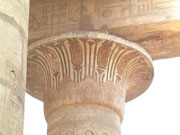TOUR NEWS - RAMESSES EGYPT FEBRUARY 2008
The Ramesses Tour of Egypt for February 2008 took place from the 6th to the 27th February. The group of 18 participants included: Elizabeth Anderson, Marilyn Burke, Christopher Cook and his mother Margaret Debenham, Pauline Elliott, Wayne and Jill Fairclough, Margaret Gaydon, Anna Johnson, Alex Kennedy and Kerry Lapworth, Angela La Loggia, Judith Lewis, Betty Ruithven and her daughter Kathryn Manning, Kerry and Janet Peadon and Susan Turner. The tour leader and guide was the author of this newsletter, Dr Michael Birrell, and the program was accompanied by our Egyptian guide Mohamed Aziz.
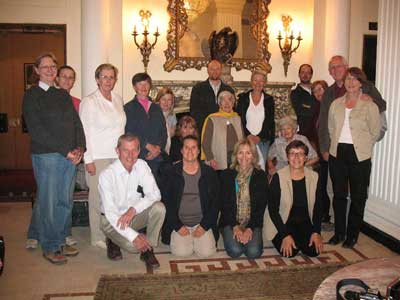 |
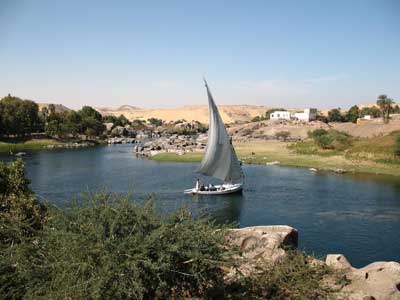 |
The February 2008 Egypt tour group |
Felucca in Aswan |
Our flight on Singapore Airlines arrived into Cairo in the late evening and we checked into the Cosmopolitan Hotel, located in the centre of the downtown area. The following morning we went to Giza where we saw the Great Pyramid. We enjoyed seeing the remarkable cedar boat of Khufu and then visited the pyramid of Khafre and saw the Sphinx. Lunch was spent at a caf� in Giza before heading off to the Khan el-Khalili markets.
The following morning we went by bus to see the ruins of Bubastis and Tanis. A highlight of Tanis is the inscribed tombs of the 21st and 22nd Libyans Kings where the famous Tanis treasure was found. The next morning we flew to Aswan where we visited the painted tombs of the Old Kingdom governors of Aswan. We reached the cemetery by felucca sailboat and climbed the stairs to the tombs. It was a perfect sunny day with magical views across the entire area. In the afternoon we took our boat to Kitchener's Island, where we toured the botanical gardens of Aswan, and had lunch in the Nubian restaurant with views across Elephantine Island.
On the 10th February we visited the fascinating granite quarries of Aswan and saw the remarkable unfinished obelisk which is still embedded in the rock. We also stopped at the Aswan High Dam, before heading by boat to the island of Philae, cult place of Isis, said by many to be Egypt's most beautiful temple. We had a pleasant picnic in sight of the superb monumental bark shrine.
The following day we joined our cruise boat, the MS Tania. This is a smaller boat than the others on Lake Nasser and had the advantage that we had the Nubian temples almost to ourselves. On the first day we explored the beautiful painted rock-cut temple of Ramesses II at Beit el-Wali, moved from its original location to near the Aswan High Dam. We also explored the impressive Roman Period temple of Kalabsha dedicated to the Nubian god Mandulis and saw the picturesque Kiosk of Qirtassi, re-erected with a view over Lake Nasser. The next day we visited the picturesque temple of Wadi es-Sebua, constructed by Ramesses the Great. Most of us took a camel ride across the desert landscape to see the ruins of the Temple of Dakka (Ptolemaic Period) and the Roman shrine of Maharakka. We also had a chance to pat a crocodile, perhaps with dreams of shoes or other accessories!
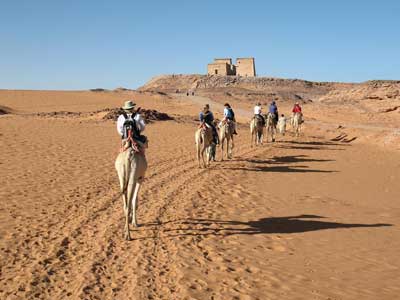 |
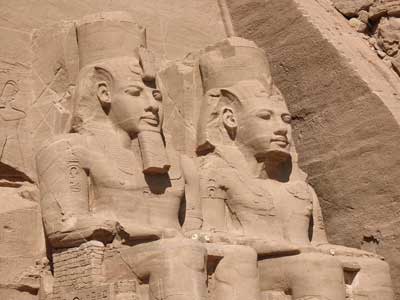 |
Camels across the desert at Wadi es-Sebua |
The splendours of Abu Simbel |
Our cruise on Lake Nasser continued with time to relax, read and watch the passing of the Nubian landscape. During the day we saw Kasr Ibrim and the romantic desert Temples of Amada (18th Dynasty) and Derr (Ramesses the Great). Our destination was the incomparable Abu Simbel, the remarkable Nubian temples of Ramesses II and his wife Nefertari. We had the chance to spend as much time as we liked at the temples and most of us went to see the Sound and Light Show in the evening.
The following day we flew back to Aswan and headed by bus to Luxor - en route we stopped to see the superb Ptolemaic temple of Sobek at Kom Ombo and the temple at Edfu, which is so well preserved that you can imagine that the temple is still being used. We checked into our hotel, the Mercure Hotel, our base for a week.
We saw Luxor Temple, located in the heart of the modern city. In the evening some of us went to watch a display of sufi dancing and most of us enjoyed a puff of a water pipe. The next morning, the 17th February, we walked across the Theban Hills for a spectacular view over the Nile Valley. Our walk began at Deir el Medina and took us to the famous mortuary temple of Queen Hatshepsut of the 18th Dynasty. There was much interest in exploring for worked flint tools which are scattered along the path. In the afternoon we went to the Valley of the Kings where we saw three royal tombs of the New Kingdom. We also saw the mortuary temple of King Sety I of the 19th Dynasty. This temple contains some of the most delicate relief sculptures from the Ramesside Period.
Our exploration of the Luxor area also included a visit to Deir el Medina workmen's village and a number of the beautiful painted tombs belonging to high officials of the New Kingdom. This included the tomb of Ramose, famous for its fine carved relief. The afternoon of the 19th February was spent looking at the ruins of the Mortuary Temple of Ramesses II, also known as the Ramesseum. In the evening we celebrated Angela's birthday with an Italian meal.
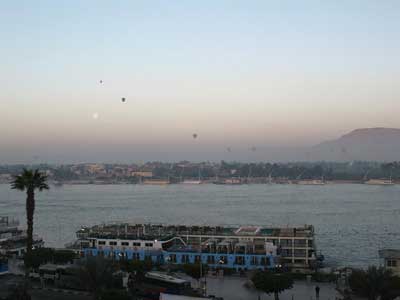 |
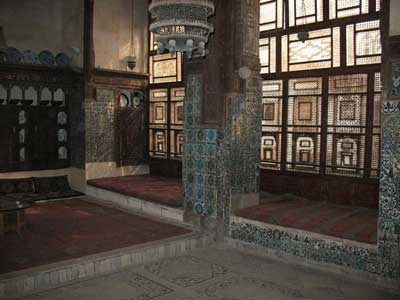 |
Balloons over Luxor - stunning! |
The Beit Sohaymi mediaeval house |
The next morning we headed north by bus to see the temples of Abydos. These superb painted temples contain beautiful wall reliefs. We also saw the Osireon, mythological tomb of Osiris, and the Temple of Ramesses II. After a picnic lunch we headed south to Luxor, stopping en route at the impressive Ptolemaic Temple of Hathor at Dendera. The following day was set aside for rest and relaxation. A number of our group went for a balloon ride.
We next explored the vast Temple of Karnak. We travelled by small motorboat to the temple site and took most of the day to explore the many halls, courts and shrines at the site. Our final day in Luxor included a visit to the temple of Medinet Habu, mortuary temple of Ramesses III. This building is famous for its magnificent war reliefs and coloured scenes of religious processions. We had a birthday celebration for Margaret Debenhan with a special Egyptian feast at the Amun Gezira Hotel
We flew to Cairo and saw some of the awe inspiring buildings of the Islamic Period. A high-light was the monumental 19th Century Mosque of Mohamed Ali in the Citadel of Saladin and the awe-inspiring medieval Mosque of Sultan Hassan. The day ended in the Khan el-Khalili markets with time set aside for last minute shopping. Many of us went to see the beautiful Beit Sohaymi, a late Ottoman House which has recently been restored. From Cairo we next drove to Saqqara where we saw the remarkable Third Dynasty Step Pyramid of Djoser. We explored the Old Kingdom mastaba tombs of Mereruka and Kagemni and entered the Pyramid of King Tety. In the afternoon we visited the ruins of Memphis and had our farewell dinner in the Marriott Palace (with the best creme brule!). Our last day was set aside for the Cairo Museum. We concentrated on the statues and reliefs of the 18th Dynasty and Ramesside Period including the treasures of Tutankhamun. All in all a most enjoyable tour with a very enthusiastic group of Egyptophiles.
Michael Birrell
